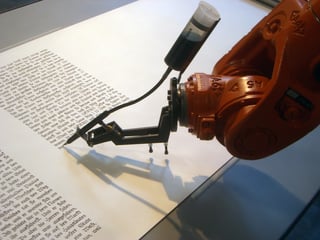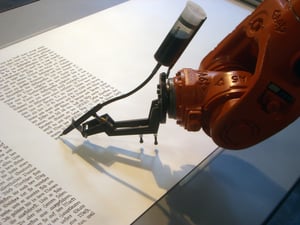Editor's Note: This post was originally published on Marketing Artificial Intelligence Institute (MAII), a new community for modern marketers created and powered by PR 20/20.
 Gartner predicts that a full 20 percent of business content will be written by machines starting in 2018. This is a startling claim. The analyst firm says: “Business content, such as shareholder reports, legal documents, market reports, press releases, articles and white papers, are all candidates for automated writing tools.”
Gartner predicts that a full 20 percent of business content will be written by machines starting in 2018. This is a startling claim. The analyst firm says: “Business content, such as shareholder reports, legal documents, market reports, press releases, articles and white papers, are all candidates for automated writing tools.”
Will artificial intelligence automate content creation? It’s a legitimate question. If Gartner is talking about the issue, it’s worth considering. Artificial intelligence technologies are advancing rapidly, to the point where the Associated Press now has machines writing full earnings reports. Marketers rely on content more than ever as a linchpin of their strategies. What if the creation of content was suddenly the responsibility of a machine, not a marketer?
The Marketing Artificial Intelligence Institute was created to understand how AI technologies are transforming marketing. We’ve profiled companies that specialize in automating content creation, like Narrative Science and Automated Insights. And we thought it valuable to answer this question for marketers concerned about their jobs, strategies and budgets.
To begin answering the question, we need to look at two key technologies that make automatic content creation possible: natural language generation (NLG) and natural language processing (NLP).
What Content Automation Actually Involves
Natural language generation (NLG) is an AI technology that takes structured data and turns it into text. How the data is translated depends on how the system’s creators code its translation rules. In other words, you “teach” a NLG system the relationships between data points.
For instance, the Associated Press and Automated Insights work together to “teach” the Automated Insights system each rule for successfully translating financial data into a text-based earnings report that reads just like one written by a human.
Here’s an example of a rule they might code into the system: a rise of 20 percent or more when comparing two data points over time should be written as “a significant increase” in the final report. Once that rule is written, the system would automatically refer to a rise of 20 percent or more as “a significant increase” when presented with properly structured data. Thousands of human-coded rules like this work together with the machine’s various other algorithms to create full written reports from data.
These NLG systems already exist. However, they generally require extensive work to tailor the system to particular content needs. An earnings report is relatively easy to break down into its constituent parts: you report rises and falls in various metrics, which are linked together by commentary about each rise and fall.
Compare that to the following use case:
A B2B software brand in the productivity space wants a 1,000-plus word post on time-tracking tools and their evolution over time. The content will be used to attract users who are interested in other solutions on the market, then prove how this brand’s next-generation solution is actually superior.
It would be prohibitively difficult, as of late 2016, to code a system to write this article—and you would need a data set from which to translate numbers into words. Until a machine could comb the internet, perform research and combine that research into a sensible structure, complete with human-quality narrative, you’re out of luck.
This isn’t to say the technology won’t exist to do that. It may even be developed sooner than we think. But it does highlight that there isn’t a single “writing” category to automate. There are many different types of narratives, and some of the narratives written around datasets can currently be automated. Even within those datasets, it may take a prohibitive amount of time, work and energy to customize an NLG platform to represent that data in writing.
Major strides forward may occur as natural language processing (NLP) develops. This term refers to a machine interpreting what human language means with an acceptable degree of accuracy. We might call this the machine “understanding” what is written. In some usages, NLP might also include elements of NLG, as a machine processes language, then generates more of it based on its understanding of a text. Siri and Alexa are two examples of consumer technologies that combine NLG and NLP.
Related: The Marketer’s Guide to Artificial Intelligence Terminology.
So, will artificial intelligence automate content creation?
The answer is: right now, it depends on the content. Structured data paired with the right AI tool can be automated to produce in seconds thousands of similar narratives. Every time a different type of narrative is needed, the AI tool or system must be customized to produce that narrative. Once it is, then thousands more narratives of that type, generated from a structured dataset, can be automatically produced.
If you’re considering content automation’s potential for your brand, here are a few questions to think about before diving in.
Questions to Ask If You’re Considering Content Automation
1. What kind of data does my brand have access to?
You’ll need to have some type of structured data—data commonly arranged in columns and rows, like in a spreadsheet. As an example, the Associated Press has access to a continuous stream of earnings data in a structured format. Once it uses an AI tool to create an automated template for that data, it can apply the template to new data as it’s generated, provided it’s in the same format.
2. What narratives can I tell with that data?
What stories are you already manually telling with your numbers? What stories would be profitable for you to tell if you had unlimited time or budget? Many different datasets have stories to tell, and many can be automated. But currently it takes human insight to determine which stories will be the most useful.
Additionally, any time you communicate the findings of an internal report or dataset, you’re also telling a story. You may be able to profitably automate internal reporting of this kind.
3. Should my brand even consider content automation?
The usefulness of content automation for your brand is highly dependent on your unique situation.
Do you require content at scale? If not, it might not be worth the time and energy to customize NLG technologies for automation.
Are you prepared to invest beyond the initial setup of NLG? These narratives are often imperfect. Additional editing, tweaking and improvements may be required. You’ll still need to invest significantly in human content specialists to manage the machines.
Does your brand have the talent to implement NLG? It’s not your typical creative writing exercise. NLG implementation requires a solid understanding of rules-based and branching logic, as well as a deep understanding of fundamental narrative mechanics.
Have more questions about automating content creation and what’s possible with artificial intelligence? Get in touch with us at MAII. (And don’t forget to subscribe for more articles like this one.)

%20Logo_BlueOrange_Trademark.png?width=800&height=269&name=Ready%20North%20(RN)%20Logo_BlueOrange_Trademark.png)




.jpg?width=300&name=Services%20Hub%203%20(3).jpg)


COMMENTS